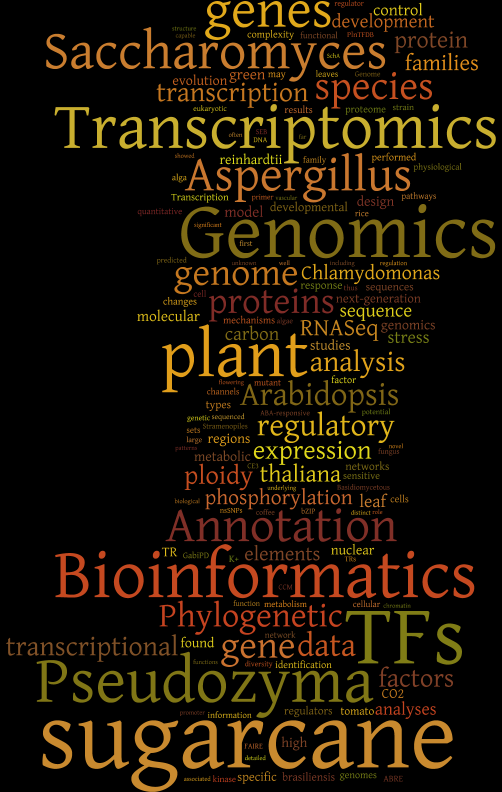Projects
Surveying the complex polyploid sugarcane genome sequence using synthetic long reads
During the last couple of years we have been exploring the Illumina's Synthetic Long reads to explore the genome of the sugarcane cultivar SP80-3280. The current version of the genome assembly and annotation is at a stage where external user can find it useful, so we decided to start releasing this information to the general public following similar term to those used by JGI/DOE genome sequencing project to make release information prior to scientific publication. If you are interested, please follow the links below.
- Technical memorandum
- Access to genome data
Sugarcane gene catalogue
One of our first projects, contributing towards a comprehensive Sugarcane gene catalogue, is a study of the leaf development in Sugarcane, genotype SP80-3280. The leaf of C4 plants, such as sugarcane have a developmental gradient along the leaf. We have studied the sugarcane leaf +1 (First leaf from top to bottom with the delawp fully exposed), examining four different segments. More details are available in Mattiello et al., 2015, and here.
Análise genômica da levedura xilanolítica Pseudozyma brasiliensis
Team: Prof. Dr. Gustavo H. Goldman (USP), Dr.rer.nat. Diego M. Riano-Pachon (CTBE), Juliana Velasco de Castro Oliveira (CTBE) and Master student Renato Augusto Correa dos Santos
Brazil is responsible for 33% of the biethanol production in the world and dominates the technology for its production using hexoses and their dissacharides available in sugarcane. The use of pentoses present in lignocellulosic biomass, as in sugarcane bagasse, is a promising option for production of second generation bioethanol. However, industrial strains of Saccharomyces cerevisiae usually employed in the ethanolic fermentation process are naturally not able to ferment these sugars efficiently. The family Ustilaginaceae (Basidiomycota) has members with high biotechnological potential, including the yeasts of the genus Pseudozyma. Recently, our group isolated the strain Pseudozyma brasiliensis GHG001, producing a xylanase with high potential of xylan hydrolysis, as well as capacity of growth in xylose and xylan as unique carbon sources. Thus, this yeast is promising as source of genes and pathways for constructing recombinant S. cerevisiae. The aims of this work are (i) improvement of the genome annotation of P. brasiliensis GHG001, (ii) study comparative genomics of P. brasiliensis with other members of Ustilaginaceae, especially the gene families involved in biomass hydrolysis, pentose catabolism, oxidation-reduction and isomerization, including the genome of four Pseudozyma isolates already sequenced in our lab, (iii) the reconstruction of a draft of metabolic networks in P. brasiliensis, and (iv) in silico exploitation of interesting pathways using flux balance analysis.
Dual RNA-seq of semi-industrial fermentations with Saccharomyces cerevisiae CAT-1 and two bacterial isolates, frequently found contaminating industrial ethanolic fermentations.
Team: Prof. Dr. Carlos A. Labate (USP), Dr.rer.nat. Diego M. Riano-Pachon (CTBE) and PhD student Lucas Lopes
Ethanol has a great strategic importance for the brazilian energy sector due to its renewable nature and great capacity to generate employment and income. Furthermore, the use of ethanol has reduced brazilian dependence on fossil fuels. Currently, one of the main problems faced in ethanol production is the presence of contaminating microorganisms during the fermentation process. Their presence during fermentation can cause a reduction in efficiency of ethanol production, competition for essential nutrients and increase of toxic compounds levels that cause yeast flocculation. Even with these problems, most of the ethanol production process in Brazil are based on a complex interaction between the yeast S. cerevisiae and contaminating organisms. In this sense, this project aims to carry out DNA sequencing, assembly of genomes and complete annotation of two isolates of bacterial contaminants from different sugarcane mills in the state of São Paulo, belonging to the genus Lactobacillus and Acetobacter. Furthermore, it is also aims to peform the sequencing of CAT-1 S. cerevisiae transcripts and these contaminants in coexisting conditions, in fermentation trials conducted in semi-industrial reactors. We expect to better comprehend some of the interaction dynamics between these microrganisms.



